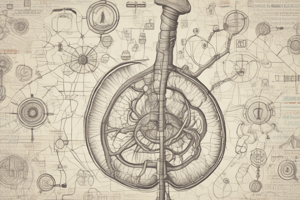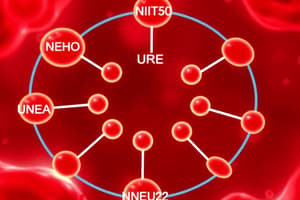Podcast
Questions and Answers
What is the main consequence of defects in any of the five enzymes of the urea cycle?
What is the main consequence of defects in any of the five enzymes of the urea cycle?
- Increased breakdown of proteins
- Increased production of urea
- Build-up of blood ammonia (hyperammonemia) (correct)
- Enhanced renal function
Which of the following conditions is most likely associated with pre-renal elevation of blood urea?
Which of the following conditions is most likely associated with pre-renal elevation of blood urea?
- Acute glomerulonephritis
- Polycystic kidney disease
- Major surgery (correct)
- Enlargement of the prostate gland
How much urea is typically excreted in urine by a healthy individual each day?
How much urea is typically excreted in urine by a healthy individual each day?
- 10-20 g
- 5-10 g
- 30-45 g
- 15-30 g (correct)
Which statement accurately describes the energetics of the urea cycle?
Which statement accurately describes the energetics of the urea cycle?
What condition is implied by the term 'azotemia'?
What condition is implied by the term 'azotemia'?
What is the primary reason for ammonia toxicity in the body?
What is the primary reason for ammonia toxicity in the body?
Which of the following symptoms is NOT associated with ammonia intoxication?
Which of the following symptoms is NOT associated with ammonia intoxication?
What accounts for the majority of nitrogen-containing substances excreted in urine?
What accounts for the majority of nitrogen-containing substances excreted in urine?
Which cycle is responsible for the detoxification of ammonia into urea?
Which cycle is responsible for the detoxification of ammonia into urea?
Where is urea primarily synthesized in the body?
Where is urea primarily synthesized in the body?
What is the role of glutamate in the context of ammonia accumulation?
What is the role of glutamate in the context of ammonia accumulation?
How many amino groups does urea contain, and what sources do they derive from?
How many amino groups does urea contain, and what sources do they derive from?
What effect does increased ammonia concentration have on α-ketoglutarate?
What effect does increased ammonia concentration have on α-ketoglutarate?
What is the primary metabolic process through which ammonia is liberated from amino acids?
What is the primary metabolic process through which ammonia is liberated from amino acids?
What form of ammonia is predominantly found at physiological pH?
What form of ammonia is predominantly found at physiological pH?
What is the consequence of NH3 absorption from the intestine into portal venous blood?
What is the consequence of NH3 absorption from the intestine into portal venous blood?
Which condition is commonly associated with acquired hyperammonaemia?
Which condition is commonly associated with acquired hyperammonaemia?
What physiological condition can lead to NH3 intoxication due to bypassing the liver?
What physiological condition can lead to NH3 intoxication due to bypassing the liver?
What is the significance of managing ammonia levels in the body?
What is the significance of managing ammonia levels in the body?
Which of the following biogenic amines is NOT a neurotransmitter?
Which of the following biogenic amines is NOT a neurotransmitter?
What can prolonged hyperammonaemia lead to in a patient’s condition?
What can prolonged hyperammonaemia lead to in a patient’s condition?
Flashcards
Urea Cycle
Urea Cycle
A group of metabolic reactions that convert ammonia into urea, a less toxic compound that can be excreted by the kidneys.
Hyperammonemia
Hyperammonemia
The build-up of ammonia in the blood, primarily due to inherited defects in urea cycle enzymes.
Flapping Tremor
Flapping Tremor
A flapping tremor that can occur in hyperammonemia and hepatic coma.
GABA (gamma-aminobutyric acid)
GABA (gamma-aminobutyric acid)
Signup and view all the flashcards
α-ketoglutarate
α-ketoglutarate
Signup and view all the flashcards
Amino Acid Metabolism
Amino Acid Metabolism
Signup and view all the flashcards
Liver
Liver
Signup and view all the flashcards
Kidneys
Kidneys
Signup and view all the flashcards
Urea Cycle - Energy Consumption
Urea Cycle - Energy Consumption
Signup and view all the flashcards
Urea Cycle Disorders
Urea Cycle Disorders
Signup and view all the flashcards
Normal Blood Urea Levels
Normal Blood Urea Levels
Signup and view all the flashcards
Uremia
Uremia
Signup and view all the flashcards
Ammonia (NH3) production
Ammonia (NH3) production
Signup and view all the flashcards
Ammonia absorption and transport
Ammonia absorption and transport
Signup and view all the flashcards
Liver's role in ammonia detoxification
Liver's role in ammonia detoxification
Signup and view all the flashcards
Urea excretion
Urea excretion
Signup and view all the flashcards
Acquired hyperammonemia
Acquired hyperammonemia
Signup and view all the flashcards
Inherited hyperammonemia
Inherited hyperammonemia
Signup and view all the flashcards
Hyperammonemia symptoms
Hyperammonemia symptoms
Signup and view all the flashcards
Study Notes
Ammonia Metabolism
- Ammonia is a byproduct of amino acid metabolism, transamination, and deamination, as well as other nitrogenous compounds like biogenic amines and nitrogenous bases in purines or pyrimidines.
- Intestinal bacteria, like urease, also produce ammonia from urea.
- Ammonia is toxic, particularly to the central nervous system (CNS).
- The liver converts ammonia to less toxic urea, and excretes it in urine.
Ammonia Transport
- Ammonia is transported in the blood in the form of ammonium ions (NH4+).
- The hepatic portal vein carries blood from the gastrointestinal tract to the liver, where high concentrations of ammonia are found compared to systemic blood.
- The liver quickly removes ammonia from the portal blood, making blood leaving the liver virtually ammonia-free.
- This detoxification process is critical as even small amounts of ammonia are toxic to the CNS.
Biogenic Amines
- Biogenic amines include dopamine, norepinephrine, epinephrine, histamine, and serotonin. These are important neurotransmitters.
- Catecholamines (dopamine, norepinephrine, and epinephrine) and histamine are other nitrogenous compounds metabolized by similar mechanisms.
Clinical Significance of Ammonia
- Severe liver impairment can cause collateral circulation in the liver, which bypasses the liver, leading to higher ammonia levels.
- Surgical procedures like Eck-fistula can also create alternative pathways for blood flow.
- Elevated ammonia levels (Hyperammonemia) is associated with neurological problems like coma and mental retardation.
- Elevated ammonia can cause a distinctive neurological tremor known as a flapping tremor.
- Increased ammonia levels impair neuronal function.
Hyperammonemia (Classification)
- Acquired hyperammonemia: Often due to cirrhosis of the liver or other liver diseases that impair the liver's ability to process ammonia.
- Inherited hyperammonemia: Resulting genetic defects in urea cycle enzymes, leading to impaired ammonia detoxification.
Glasgow Coma Scale (GCS)
- A scale used to assess the level of consciousness.
- A tool commonly used in medical settings, in particular in cases of trauma or neurological dysfunction, with scoring used to classify the severity.
Mechanism of Urea
- The urea cycle is a metabolic pathway for converting ammonia (toxic) into urea (less toxic).
- The urea cycle is critical, converting ammonia to less toxic substances that can be excreted by the body.
- The Urea cycle involves five sequential enzymatic reactions, with the first two in the mitochondria and the remaining in the cytoplasm.
- The cycle also involves several important intermediates like citrulline, argininosuccinate, and arginine.
- This cycle links with the citric acid cycle (TCA) through fumarate
- It is a five-step cyclic process, using five different enzymes.
- Urea is the end product of the protein metabolism, the excess nitrogen is converted to urea.
- Urea is excreted as part of urine.
- Urea accounts for 80-90% of nitrogen excretion.
Urea Cycle Enzymes
-
Reaction 1: Synthesis of carbamoyl-phosphate (mitochondrial)
-
Reaction 2: Synthesis of citrulline (mitochondrial).
-
Reaction 3: Synthesis of argininosuccinate (cytosolic).
-
Reaction 4: Cleavage of argininosuccinate (cytosolic).
-
Reaction 5: Cleavage of arginine to form ornithine and urea (cytosolic)
-
Ammonia and CO2 combine to produce carbamoyl phosphate.
-
The enzyme arginase catalyzes hydrolysis and the guanidine group, releasing urea and regenerating ornithine.
-
The cycle requires 3 ATP molecules for each cycle, with 2 spent for the creation of carbamoyl phosphate and 2 during production of Arginosuccinate.
Protein Turnover
- Humans constantly break down and synthesize proteins.
- Proteins are major nitrogenous sources in the body.
- Protein turnover plays a significant role in nitrogen metabolism and waste production.
- 1-2% of the total body protein is turned over daily, mostly in muscles.
- Protein breakdown produces amino acids, some of which will contribute to the production of nitrogenous wastes that need processing by the liver for detoxification.
Ammonia Toxicity
- High ammonia levels can increase glutamine formation and decrease the formation of GABA.
- This disruption can lead to neurological symptoms, including tremors.
- Flapping tremors are a common neurological sign associated with high ammonia levels.
- Disruptions to the TCA cycle and neurotransmitter function are consequences of high ammonia.
Clinical Importance of Blood Urea
- Normal blood urea levels range from 10-40 mg/dL.
- Higher protein intake can increase blood urea marginally.
- 15-30 grams of urea are typically excreted daily in the urine.
- Blood urea is a screening test to assess kidney function.
- Elevated blood urea levels, can be classified as pre-renal, renal and post-renal.
Pre-renal azotemia and elevation in blood urea
- Increased protein breakdown (after major surgery, prolonged fever, diabetic coma).
- Elevated in conditions like leukemia (anemia of blood).
Renal azotemia and elevation in blood urea
- Conditions like acute glomerulonephritis, chronic nephritis, nephrosclerosis, polycystic kidney disease.
Post-renal azotemia and elevation in blood urea
- Obstructions in the urinary tract (tumors, stones, or enlarged prostate).
- This causes increased reabsorption of urea in kidney tubules.
Studying That Suits You
Use AI to generate personalized quizzes and flashcards to suit your learning preferences.




